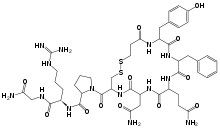Desmopressin
 | |
 | |
| Systematic (IUPAC) name | |
|---|---|
|
(2S)-N-[(2R)-1-[(2-amino-2-oxoethyl)amino]-5- (diaminomethylideneamino)-1-oxopentan-2-yl]-1- [(4R,7S,10S,13S,16S)-7-(2-amino-2-oxoethyl)-10- (3-amino-3-oxopropyl)-16-[(4-hydroxyphenyl)methyl]- 6,9,12,15,18-pentaoxo-13-(phenylmethyl)1,2-dithia- 5,8,11,14,17-pentazacycloicosane-4-carbonyl] pyrrolidine-2-carboxamide | |
| Clinical data | |
| Trade names | Ddavp, Minirin, Minirin Melt, Octim, Stimate |
| AHFS/Drugs.com | monograph |
| |
| IV, IM, SC, intranasal, oral | |
| Pharmacokinetic data | |
| Bioavailability | Variable; 0.08–0.16% (oral) |
| Protein binding | 50% |
| Half-life | 1.5–2.5 hours |
| Excretion | Renal |
| Identifiers | |
|
16679-58-6 | |
| H01BA02 | |
| PubChem | CID 5311065 |
| DrugBank |
DB00035 |
| ChemSpider |
10481973 |
| UNII |
ENR1LLB0FP |
| KEGG |
D00291 |
| ChEMBL |
CHEMBL376685 |
| Chemical data | |
| Formula | C46H64N14O12S2 |
| 1069.22 g/mol | |
|
SMILES
| |
| |
| | |
Desmopressin (trade names: DDAVP, DesmoMelt, Minirin, Minirin Melt, Octim, Stimate) is a synthetic replacement for vasopressin, the hormone that reduces urine production. It may be taken nasally, intravenously, or as an oral or sublingual tablet. Physicians prescribe desmopressin most frequently for treatment of diabetes insipidus, bedwetting, or nocturia.
Chemistry
Desmopressin (1-desamino-8-D-arginine vasopressin) is a man-made form of the normal human hormone arginine vasopressin (the antidiuretic hormone, or ADH), a peptide containing nine amino acids and so on.
Compared to vasopressin, desmopressin's first amino acid has been deaminated, and the arginine at the eighth position is in the dextro rather than the levo form (see stereochemistry).
Medical uses
Bed wetting
Desmopressin is used to treat nocturnal enuresis (bedwetting). It is usually prescribed in the form of oral desmopressin acetate, DDAVP.People taking DDAVP are 4.5 times more likely to sleep without disruption compared with placebo.[1][2]
US drug regulators banned treating nocturnal enuresis with desmopressin nasal sprays after two patients died and fifty-nine other patients suffered seizures. The patients were using desmopressin when they developed hyponatremia, an imbalance of the body's sodium levels.[3]
To enforse the ban US drug regulators made the nasal spray only sold at a mail order pharmacy run by the FDA and only for adults who don't have a history of nocturnal enuresis.
Nighttime urination
Desmopressin has some benefit in adults who have problems with night time urination (known as nocturia).[4]
Clotting disorders
Desmopressin can be used to promote the release of von Willebrand factor (with subsequent increase in factor VIII survival secondary to vWF complexing) in patients with coagulation disorders such as von Willebrand disease, mild hemophilia A (factor VIII deficiency), and thrombocytopenia. It can be used with uremic induced platelet dysfunction. It is not effective in the treatment of hemophilia B (factor IX deficiency) or severe hemophilia A.
Diabetes insipidus
Desmopressin is used in the treatment of central diabetes insipidus (DI), to replace endogenous ADH that is missing in the central nervous system type of this disorder (decreased production of ADH from the posterior pituitary). It is also used in the diagnostic workup for diabetes insipidus, in order to distinguish central from nephrogenic DI.
Side effects
- headaches
- facial flushing
- nausea
- hyponatremia
- seizures
FDA regulators have said that desmopressin tablets can still be considered safe for treatment of nocturnal enuresis as long as the patient is otherwise healthy. Patients must stop taking desmopressin if they develop severe vomiting and diarrhea, fever, the flu, or severe cold. Patients should also be very cautious about taking desmopressin during hot weather conditions or following strenuous exercise, as these conditions can place stress on the body's salt and water balance.
A healthy body needs to maintain a balance of water and salt (sodium). If sodium levels become too low (hyponatremia) – either as a result of increased water take-up or reduced salt levels – a person may have seizures and, in extreme cases, may die.[5]
Mechanism of action
Desmopressin works by limiting the amount of water that is eliminated in the urine. It works at the level of the renal collecting duct by binding to V2 receptors, which signal for the translocation of aquaporin channels via cytosolic vesicles to the apical membrane of the collecting duct. The presence of these aquaporin channels in the distal nephron causes increasing water reabsorption from the urine, which becomes passively re-distributed from the nephron to systemic circulation by way of basolateral membrane channels.[6] Desmopressin also stimulates release of von Willebrand factor from endothelial cells by acting on the V2 receptor.
Desmopressin is degraded more slowly than recombinant vasopressin, and requires less frequent administration. In addition, it has little effect on blood pressure, while vasopressin may cause arterial hypertension. Vasopressin stimulates the release of ACTH, which indirectly increases responsiveness of alpha-1 receptor in blood vessel smooth muscle, increasing vessel tone and blood pressure. Desmopressin does not stimulate ACTH release, and therefore does not directly raise blood pressure.
References
- ↑ Evans, JH (2001). "Evidence based management of nocturnal enuresis". BMJ (Clinical research ed.) 323 (7322): 1167–9. doi:10.1136/bmj.323.7322.1167. PMC 1121645. PMID 11711411.
- ↑ "La prise en charge de l’énurésie nocturne primaire". Paediatr Child Health 10 (10): 616–620. 2005. PMC 2722621. PMID 19668677.
- ↑ 2 Deaths Spur sleep apnea Drug Warning. Webmd.com (2007-12-04). Retrieved on 2011-04-18.
- ↑ Ebell, MH; Radke, T; Gardner, J (Sep 2014). "A systematic review of the efficacy and safety of desmopressin for nocturia in adults.". The Journal of Urology 192 (3): 829–35. doi:10.1016/j.juro.2014.03.095. PMID 24704009.
- ↑
- ↑ Friedman FM, Weiss JP (December 2013). "Desmopressin in the treatment of nocturia: clinical evidence and experience". Ther Adv Urol 5 (6): 310–7. doi:10.1177/1756287213502116. PMC 3825109. PMID 24294289.
Further reading
- Leissinger, C; Becton, D; Cornell, C Jr; Cox Gill, J (2001). "High-dose DDAVP intranasal spray (Stimate) for the prevention and treatment of bleeding in patients with mild haemophilia A, mild or moderate type 1 von Willebrand disease and symptomatic carriers of haemophilia A.". Haemophilia 7 (3): 258–66. doi:10.1046/j.1365-2516.2001.00500.x. PMID 11380629.
| ||||||||||||||||||||||||||||||||||||||||||||||||||||||
| ||||||||||||||||||||||||||||||||||||||||||||||||||||||||||||||||||||||||||||||||||||||||||||||||||||||||||||||||||||||||||||||||||||||||||||||||||||||||||||||